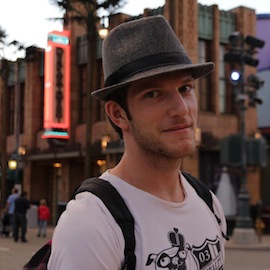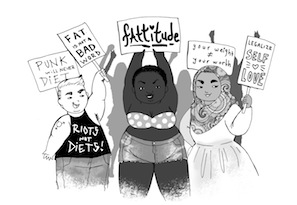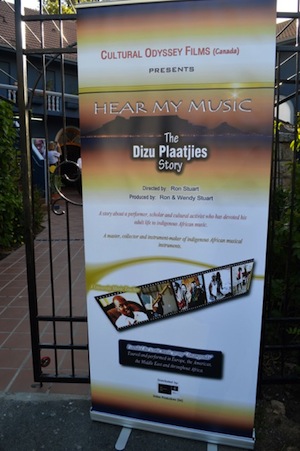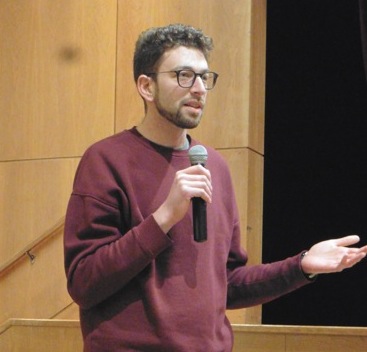Salvador Litvak was in Vancouver for a Shabbaton at the Kollel last month. (photo from Salvador Litvak)
At a Kollel Shabbaton last month featuring Accidental Talmudist and filmmaker Salvador Litvak, no one was asking that age-old Jewish question, “When do we eat?” In fact, on the night of June 23, during the first of three sessions with Litvak, more than 100 attendees sat spellbound as he shared the love story of his Hungarian grandmother Magda, who survived the Holocaust in the Theresienstadt concentration camp.
Litvak, who was born in Chile and now lives in Los Angeles, recalled his grandparents’ story and how Magda’s death led to an epiphany that jump-started his spiritual journey. According to Litvak, witnessing his grandmother passing to the next world, where she was welcomed by his grandfather Imre (who was murdered in the Holocaust), was one of the seminal experiences of his life and it eventually resulted in his becoming an “accidental Talmudist,” with many detours along the way.
Litvak revealed his story in stages over the next two days at the Kollel, which brought him to Vancouver as part of its “focus on creating and promoting exciting and meaningful, social, cultural and educational programs that invite people to experience Judaism … in an inclusive, comfortable, joyful and nonjudgmental environment,” said Kollel director Rabbi Shmuel Yeshayahu.
Over the course of the weekend, Litvak shared a drash about the Torah portion, led an interactive workshop on Sunday about discovering one’s life’s mission and traced the stages in his life that led him to create the Accidental Talmudist blog, which attracts more than one million readers (Jews and non-Jews). He also spoke about how he came to embrace his Jewish and Hispanic roots.
Litvak’s journey has been an unconventional one. In fact, during the Sunday workshop, he jokingly claimed that “smoking pot got him into Harvard” because, after the incident, his father forced him to become a runner, which led to his becoming a champion cyclist. These extracurricular activities, said Litvak, helped him get into Harvard, where he took pre-med courses but ended up at New York University Law School. When he wasn’t in the classroom, he spent time in Greenwich Village. “I was a law student by day and a poet warrior by night,” he said.
Going back to his childhood, he said, “I was born in Santiago, Chile, that’s how I ended up with such a crazy name as Salvador Litvak, which is very similar to Jesus Goldberg.”
Like most kids, he was concerned about fitting in, despite several disadvantages. “I already had foreign parents, I was too tall, my hair was bright red, unruly, a mop, and there was no way I was going to fit in,” he said. So, while he agreed with his parents’ plan for him to go to Harvard to become a doctor, he made a decision in Grade 3 to use his middle name Alex instead of Salvador because “it made him feel more American.” It wasn’t until attending a Latino Students Association annual black tie gala at NYU that he would reclaim his Latino heritage.
Litvak had not attended any of the organization’s prior events because he had only felt nominally Hispanic. He attended this one with his girlfriend on a lark because he could wear his tux and get a free meal. When he found out, to his horror, that he would have to make a speech at the gala, he thought of leaving, but then realized that “all of the events of my life had actually coalesced into this moment for a reason.”
He seized the moment and shared with the audience how he’d been passing for 17 years as a white-bread American, and vowed to use his Spanish name, Salvador, from that day forward. Even though he wasn’t plugged into Judaism during his NYU days, this reclamation would be the first step for him to also reclaim his Jewish identity. “I let that moment be a key moment in my life,” he said, “because I knew that G-d was speaking to me and was saying to me, be who you are; you can’t do anything in this world if you aren’t who you really are.”
Litvak graduated, and practised corporate law for a short time before abandoning that career (much to the chagrin of his father) to become a filmmaker. This led to another milestone in his Jewish journey – producing and directing what is now a holiday comedy classic, the story of a Passover seder gone awry entitled When Do We Eat?, starring the late Jack Klugman in his final film role, as well as Lesley Ann Warren, Max Greenfield and Ben Feldman.
By his own admission, When Do We Eat? – which was realized with the help of his wife Nina and his Vancouver cousin Horatio – is a “very irreverent and raucous movie.” Even though the movie, which is about the “fastest seder in the West,” had a deep Jewish message based on sparks of kabbalah and Chassidut, it was panned by major media like the New York Times and Roger Ebert as being anti-Jewish. Nonetheless, word-of-mouth led to the film becoming a cult classic and a Passover tradition for many Jews around the world.
While Litvak had a bar mitzvah, he wasn’t particularly connected to his Jewish roots until the day he walked into a bookstore called 613 – The Mitzvah Store in the Pico Robertson district of Los Angeles and picked up a book called Berachos. It led him on the next leg of the spiritual journey that had begun with the passing of his grandmother.
He learned from the clerk at the bookstore that he had picked up the first book of the Talmud on a special day. The Talmud is read by many Jews all over the world as part of a worldwide program called Daf Yomi (literally, “Page of the Day”). It takes seven-and-a-half years to read the whole Talmud and Litvak had bought Book One on Day One of the program. He decided that this was not a coincidence and embarked on a seven-and-a-half-year talmudic journey, which led to one of his most memorable spiritual experiences: participating in a siyum (or concluding ceremony) at MetLife Stadium in New York with 93,000 Jews.
So, picking up that book of Talmud “accidentally” at a bookstore in Los Angeles set Litvak on a journey that inspired him to establish the Accidental Talmudist blog, which features Jewish wisdom and humour, and music from Jewish artists like Matisyahu, Peter Himmelman and the Moshav Band, as well as a live weekly show that is seen in more than 70 countries. Aside from connecting Jewish souls, the blog has introduced new fans to When Do We Eat? and there are plans for an Accidental Talmudist book and movie.
As we continue to ask that vital question, “When do we eat?”, Litvak will continue to connect Jewish souls one matzah ball and one page at a time.
For more information about the Accidental Talmudist, visit accidentaltalmudist.org. For information on the new Daf Yomi class at the Kollel, led by Asaf Cohen daily, at 8 p.m., visit thekollel.com.
David J. Litvak is a prairie refugee from the North End of Winnipeg who is a freelance writer, former Voice of Peace and Co-op Radio broadcaster and an “accidental publicist.” His articles have been published in the Forward, Globe and Mail and Seattle Post Intelligencer. His website is cascadiapublicity.com. He is not related to Salvador Litvak.















 Cultural Odyssey Films and WRS Productions (comprised of Vancouver’s Ron Stuart and Wendy Bross Stuart) premièred the documentary on Feb. 15 at Labia Theatre in Cape Town, South Africa.
Cultural Odyssey Films and WRS Productions (comprised of Vancouver’s Ron Stuart and Wendy Bross Stuart) premièred the documentary on Feb. 15 at Labia Theatre in Cape Town, South Africa.



